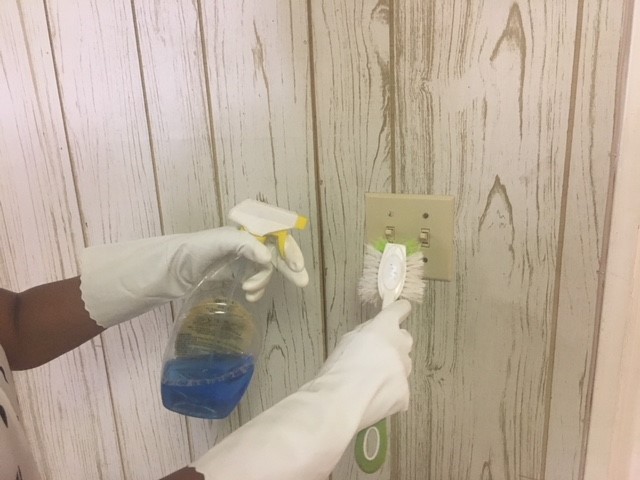
by Laurie Osgood | Mar 2, 2018
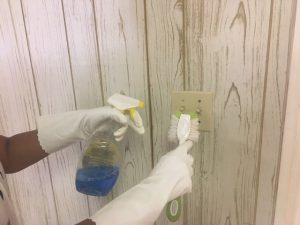
Clean light switches to reduce the spread of illnesses. Photo credit: NW Extension District
Seasonal influenza (flu) viruses are most common during the fall and winter, with peak activity occurring between December and February. According to the Centers for Disease Control and Prevention (CDC), the flu is a contagious respiratory illness caused by influenza viruses. It can cause mild to severe illness. Serious outcomes of flu infection can result in hospitalization or death. Some people, including senior adults, young children, and persons with certain health conditions, are at high risk for serious flu complications.
When someone in your family has had a cold or the flu, it is important to clean and sanitize your house properly to avoid any recurrences or further spreading. Follow these tips:
- Before you get started, try opening the windows for some fresh air, or raise your blinds or curtains to let in the natural light.
- Clean the areas first, then disinfect.
- Wash your hands often: before, during, and after cleaning.
IN THE BATHROOM
The bathroom will need a good cleaning and disinfection after an illness.
- Disinfect with a mixture of bleach and water. Use one scant teaspoon of chlorine bleach to one quart of water.
- Clean toilet lever, shower faucets, cabinet knobs, light switches, and doorknobs.
- Replace or clean toothbrushes.
|
IN THE KITCHEN
- Disinfect all things that people touch: refrigerator door handles; coffee pot; electric can opener; microwave oven; door, stove, and cabinet knobs; faucets; light switches. Do NOT use chlorine bleach with added fragrance, as it is not food-safe.
- Run all utensils through the dishwasher after each use.
- For more information on sanitizing the kitchen, see Cleaning and Sanitizing the Kitchen: Using Inexpensive Household Food-Safe Products.
|
IN THE FAMILY ROOM
- Clean remotes, phones, computer keypads, gaming systems, door knobs, and light switches.
- Sanitize all items with proper cleaning products.
|
IN THE BEDROOM
- Change pillow cases daily and wash soiled bed linens right away with proper laundry detergent.
- Wash everything in your washer on the hottest temperature the fabric allows, but be sure not to overload your washer.
- Disinfect all items on the night stand. Don’t forget light switches, doorknobs and drawer pulls, and remote controls, if used.
|
CLEANING KIDS’ TOYS
- Some stuffed animals can be cleaned in the washer with the other bedding.
- For hard-surfaced toys, make sure to clean with proper cleaning solutions for their surface and rinse well.
- Some small toys can be safely cleaned in a mesh laundry bag in the top rack of the dishwasher.
|
WHAT TOOLS ARE NEEDED?
- Rubber gloves
- A different sponge for each room you are cleaning or paper towels
- Proper cleaning products: Please be sure to follow all manufacturer’s instructions on all cleaning products.
According to the CDC, the flu virus can live on surfaces for 48 hours—potentially infecting anyone who comes in contact with the germs. Disinfecting the house is one of the best ways to prevent anyone else from contracting the illness.
For more information on sterilizing items in your home, visit the CDC Website, https://www.cdc.gov/oralhealth/infectioncontrol/questions/sterilization/cleaning.html
by Judy Corbus | Feb 3, 2018
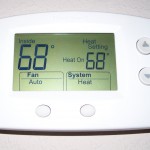
Set your thermostat to 68 degrees or lower in the winter to reduce heating costs. Photo credit: Judy Corbus
We have recently gotten a taste of what our neighbors to the north typically experience this time of year – frigid temperatures! As the mercury plummets, utility bills move in the opposite direction. Winter is not over yet so follow these easy steps to save money on your electric bill during the next cold snap:
- Set your thermostat to 68 degrees F or lower in the winter. Dress in layers for added warmth.
- Grab a throw or blanket to stay warm while reading or watching television.
- Check air filters monthly and clean or change when they become dirty. This will help your unit to operate more efficiently and last longer. A clogged filter can cause your heating system to shut down to prevent the compressor from overheating – this requires a service call to reset it.
- Use a ceiling fan, moving in a clockwise direction on low speed, to move heated air down from the ceiling into the living space. Turn fans off when leaving the room.
- Open curtains and blinds on south-facing windows to let the sun naturally warm your house. Close them at night to reduce heat loss.
- Caulk or weather-strip around windows and exterior doors to seal air leaks.
- Insulate water heater supply pipes with foam pipe wrap to reduce heat loss.
For more energy-saving tips, visit My Florida Home Energy.
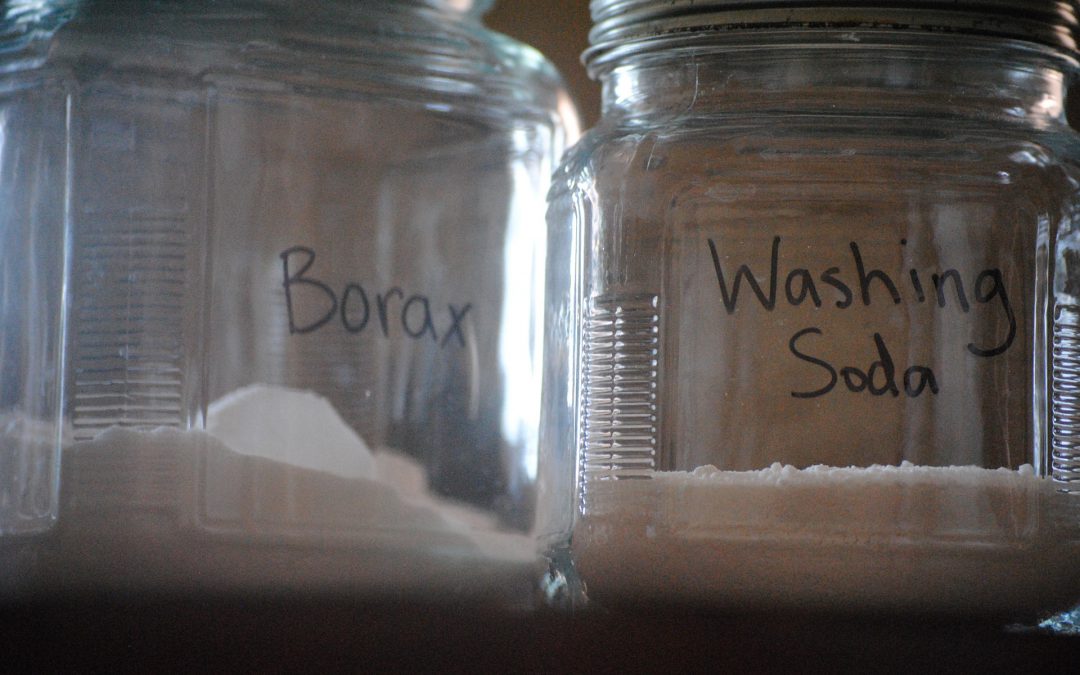
by Judy Corbus | Apr 5, 2016
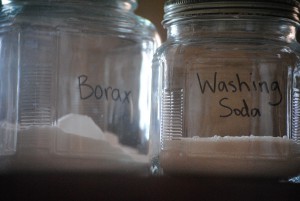 Spring has sprung and this is the perfect time to clean and freshen your house. But you don’t have to spend a lot of money on cleaning products when you can whip up your own with a few simple, inexpensive ingredients.
Spring has sprung and this is the perfect time to clean and freshen your house. But you don’t have to spend a lot of money on cleaning products when you can whip up your own with a few simple, inexpensive ingredients.
The basic ingredient list includes:
- White Vinegar
- Baking soda
- Rubbing alcohol
- Ammonia
- Mild dish detergent
- Washing soda (can be found in the laundry products aisle)
- Borax (also in the laundry section)
Use clean jars or bottles for mixing and storage. Do not use food containers – children can think the contents are something to eat. Also, don’t mix your products in empty cleaning product bottles; residue from the original product may interact with your product, causing a dangerous reaction. Label each product and store out of reach of children. NEVER mix chlorine bleach with ammonia or vinegar – it will create dangerous, toxic fumes!
Here are a few recipes to get you started:
ALL-PURPOSE CLEANER
Mix in a 16 oz. or larger spray bottle:
- 1 cup white vinegar
- 1 cup water
Use on sinks, countertops, lightly soiled range surfaces, floors, toilets, and showers.
WINDOW CLEANER
- 3 tablespoons ammonia
- 1 tablespoon white vinegar
Put in a spray bottle and fill the rest with water.
HOMEMADE LAUNDRY DETERGENT
- 1 bar Ivory® or 1/3 bar Fels Naptha® soap
- 1/2 cup washing soda
- 1/2 cup borax powder
Grate the bar soap into a cooking pot. Add 6 cups of water and heat until the soap melts. Add the washing soda and borax and stir until dissolved. Remove from heat. Pour 4 cups hot water into a clean bucket. Add the soap mixture from the pot and stir. Add 1 gallon plus 6 cups of water and stir. Let the soap sit for about 24 hours and it will gel slightly. Optional: Add 1 ounce essential oil or fragrance oil of your choice.
Use 1/2 cup per load. This is a low-sudsing soap which removes dirt and odor and can be used in high-efficiency machines.
For more product recipes, check out Homemade Household Cleaners and Green Cleaning: Recipes for a Healthy Home.
Sources: Homemade Household Cleaners
Clean It Green!, C. Rogers, UF/IFAS Extension Suwannee County.
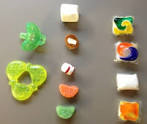
by Marie Arick | Aug 24, 2015
 Consumer Reports recently pulled their previous endorsement for laundry detergent pods in light of the potential poisoning hazard for young children. Just to be clear, this is only the laundry pods that contain the highly concentrated liquid detergent, not pods containing powdered detergent. Although these laundry pods are quickly accessed, pre-measured, use less packaging, and are just simple to use, they ultimately are not worth the lives of children. Ariana Eunjung Cha of The Washington Post recently highlighted this excerpt from Consumer Reports:
Consumer Reports recently pulled their previous endorsement for laundry detergent pods in light of the potential poisoning hazard for young children. Just to be clear, this is only the laundry pods that contain the highly concentrated liquid detergent, not pods containing powdered detergent. Although these laundry pods are quickly accessed, pre-measured, use less packaging, and are just simple to use, they ultimately are not worth the lives of children. Ariana Eunjung Cha of The Washington Post recently highlighted this excerpt from Consumer Reports:
‘When curious kids find their way into regular liquid laundry detergent, the result is often nothing worse than an upset stomach. Laundry detergent pods are presenting more serious symptoms. Along with vomiting, lethargy, and delirium, some victims have stopped breathing.’
Additionally, two children have died from ingesting a concentrated laundry detergent from a pod. Cha also noted “Last year, 11,714 reports of incidents involving kids aged 5 and younger and laundry detergent pods were reported to poison control centers nationwide. In the first six months of this year, there were more than 6,000.” This is a truly alarming fact that the numbers continue to rise. The Children’s Hospital Los Angeles posted this list on their blog:
Helpful Tips for Safety at Home
Tip 1: Cleaning materials should always be stored out of the reach of children and pets.
Tip 2: Install child-proof latches on under-sink cabinets in the kitchen and bathroom. Even if cleaning materials are no longer stored there, chemical smells may linger and could be dangerous to a child if they play under sinks.
Tip 3: Store laundry products on high shelves because many detergents can cause rashes or itching on a child’s sensitive skin.
Tip 4: Never leave a bottle or container of cleaning supplies open and unattended. Always close and put away the cleaning supplies if you are interrupted. You do not want any temptation sitting around that may harm your child.
Tip 5: When cleaning, take only the proper amount you need from the container, seal the container back up, and store the container away immediately. Use the proper equipment for handling the cleaning supply material, as recommended on the label. If the label says “Wear protective gear, gloves, or goggles,” do so to reduce harm to yourself and family.
Tip 6: When you are done cleaning, properly dispose of paper towels and rags that have come in contact with the cleaning chemicals.
Tip 7: Keep a list of emergency telephone numbers. Many cleaning products and chemicals have instructions on what to do if the product is used incorrectly, resulting in an emergency. Create and keep a first-aid kit that includes emergency-wash liquids. In the first-aid kid, keep a list of telephone numbers for:
- National Poison Control, 1-800-222-1222
- The nearest hospital
- A local ambulance service
- Your family doctor
The American Cleaning Institute urges consumers to “Pledge Now to be the KEY to a safe laundry room and routine!” Click here to take the pledge and for helpful tips for keeping your family safe.
Remember, treat all household cleaning items with care and always err on the side of caution. Look at the product you are purchasing and be aware of potential dangers. Review the warning labels and store in secured areas per label instructions. Always keep in mind: manufacturers use a product label to draw our attention to their product and this, however unintended, applies to children as well! Be diligent in keeping children safe. Personal convenience will never be more important than the life of a child.






